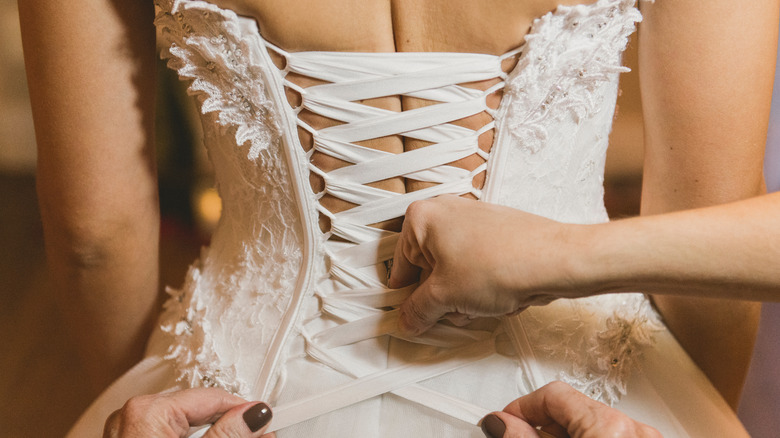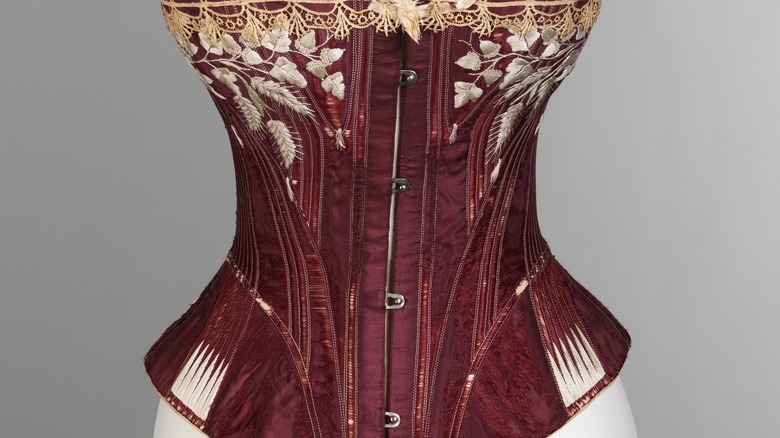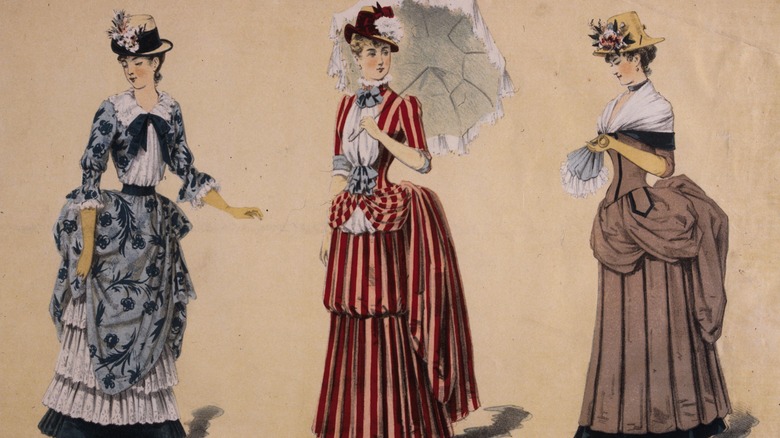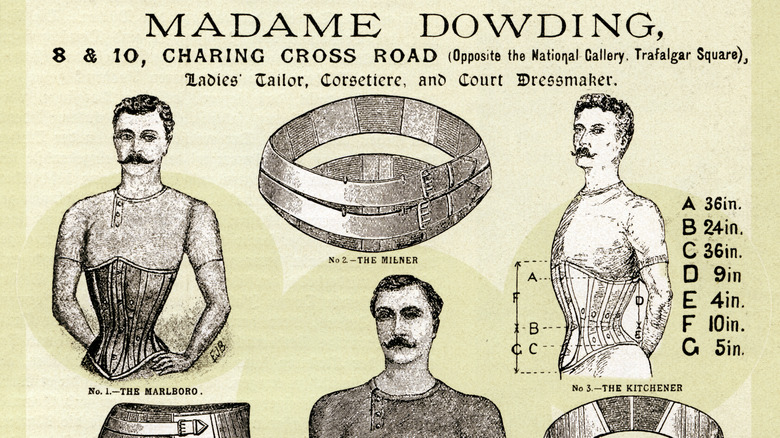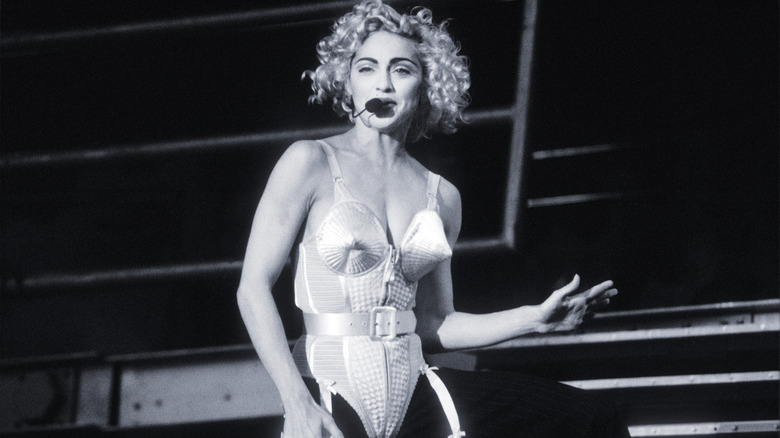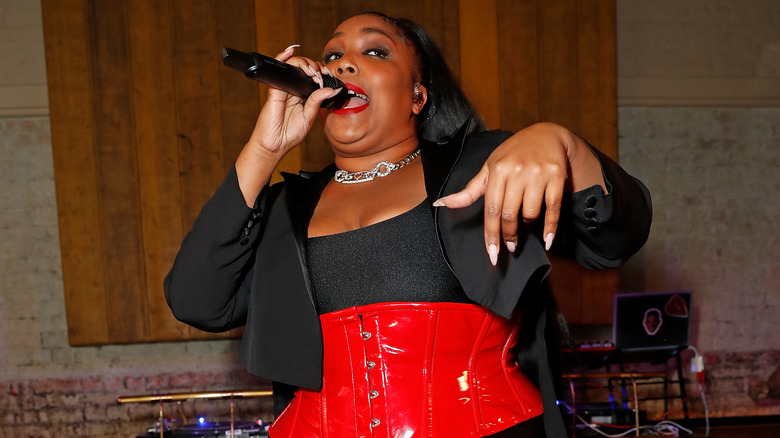The History Of Wearing Corsets And Their Troubling Side Effects
Whether it's Billie Eilish strapped in a corset on last year's cover of Vogue, Lizzo donning one with her own face superimposed on the Mona Lisa, or the legendary drag queen of corsets Violet Chachki on any given day, it seems hard to argue that corsets are making a comeback. Today, these garments come in all different shapes and sizes, from hard-cased, cinched-waisted corsets in the style of Marie Antoinette to elastic bodysuits like those worn by Lizzo when she performs.
According to The New York Times, the return of the corset can be credited to a recent obsession with Y2K fashion along with the popular Netflix show "Bridgerton" and the general transformation of "Cottagecore" — think cardigans and pastoral dresses — to "Regencycore," including "elbow-length gloves, pearl-encrusted headbands and, of course, corsets," per BBC News. Corsets, commonly used in the era of "Bridgerton" during the 19th century, have never really gone out of style, even though their history is steeped in controversy.
Origins of the corset
The first images of the corset appear in drawings as early as 1600 B.C., although they became common in the Western world in the 1700s, according to Vogue. Worn by mostly women but also some men, corsets were made of whalebone, steel, and eventually elastic, with various forms of lace threaded through the back to be cinched. They were used to shape the body into different silhouettes that were fashionable at the time — from the "hourglass shape popular in the 1800s to the 'S' figure of the 1900s," per Vogue.
Although most people who wanted to change their silhouette would try exercise and even plastic surgery starting in the 1960s, corsets never went out of style and were still used to make fashion statements with ever-evolving shapes. Vivienne Westwood famously incorporated corsets in her punk vibe of the 1970s, the designer Jean-Paul Gaultier used corsets in his 1980s designs, and Madonna wore a corset during her Blonde Ambition tour in the 1990s (via Vogue).
The corset peak
Although corsets have been around in some fashion for centuries, they were probably the most popular in the 19th century, when popular movies and television shows like "Bridgerton" and "Pride and Prejudice" take place. Corsets were seen as a demonstration of wealth used to emphasize the breasts and hourglass body shape. At the same time, many view the corsets of this time as a physical demonstration of the repression women faced.
At the time, a woman had few rights, having to marry into wealth to get out from the family home, and becoming her husband's property once she was wed (via Smithsonian Magazine). It does sound like a life almost as suffocating as a cinched, 17-inch waist.
However, not all corsets were squishing womens' organs; some were soft, comfortable, pajama-like corsets worn at home, and historians have since dispelled the idea that women were always trying to conform their bodies to a certain shape, per Smithsonian Magazine.
The side effects
With so many women wearing corsets in the 19th century, doctors started noticing certain health conditions, like fainting, that they attributed to corset use. The debilitating tautness of the corset has been commonly portrayed in films — think Rose in "Titanic," Scarlett O'Hara in "Gone With the Wind," or Elizabeth Swann in "Pirates of the Caribbean" (via Smithsonian Magazine).
Doctors also documented cases of abdominal organs and ribs compressed due to long-term corset use, as well as poor digestion and atrophied back muscles, according to the Royal College of Surgeons of England. Altogether, this corset-syndrome was called "chlorosis" or "green sickness," and was similar to anemia (via the Royal College of Surgeons of England). Another publication in one of the most famous medical journals, The Lancet, even reported a "death from tight lacing," per the Royal College of Surgeons of England.
But recently, historians have started to question if maybe these symptoms are taking away agency from women. Maybe it's the next myth about Victorian Women you can stop believing.
Does repressive equal oppressive?
According to The New York Times, the corset "has a divisive past of toeing the line between sexuality and oppression." Many see the corset in Victorian fashion as a symbol of the restrictions faced by women at the time, which were certainly enough to make you feel woozy. After all, the corset is the basis for a few sexist terms, including calling someone "straight-laced" to imply they have high morals or calling them "loose" to imply they are sexually free, according to TopTenz.
However, some argue that believing the corset to be a weapon of oppression actually feeds into the sexism that theory is condemning. In an interview with Smithsonian Magazine, Alden O'Brien, a textile curator at the Daughters of the American Revolution Museum in Washington, D.C., noted that society has placed idealized body images in front of women since the beginning of time, and "every woman will choose how far to go in the pursuit of that ideal."
Flipping the narrative
In her interview with Smithsonian Magazine, O'Brien explained that interpreting historical use of corsets as a tool of oppression "takes away female agency." In an interview with BBC News, the museum director of the New York's Fashion Institute of Technology, Valerie Steele, echoes that sentiment, suggesting that saying women "were all stupid victims for, say 400 years," is patronizing and untrue.
Hilary Davidson, a dress historian, compared the corset in an interview with Smithsonian Magazine to modern day bras. With bras being expensive, and, when ill-fitting, causing back and neck problems, what's the difference between saying bras are also an undergarment being used as a tool of oppression still today?
In recent years, men and women have elected to wear corsets more and more. Frequently found in burlesque shows or other performances, corsets have an undeniable sex appeal and went on to become a symbol for a sexually liberated woman, per BBC News.
